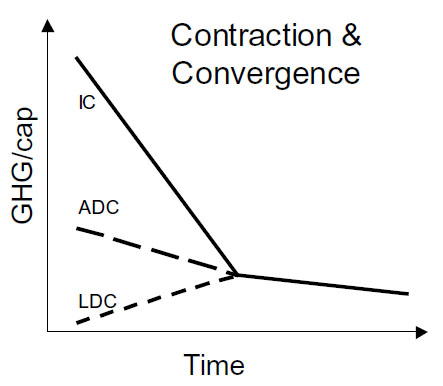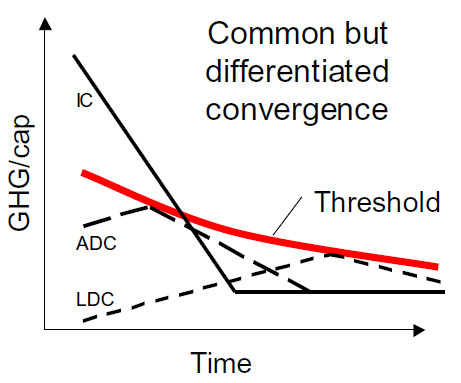Rationale for Contraction and Convergence
The Council of Ministers of the European Union agreed in June 1996 that “global average temperatures should not exceed 2°C above pre-industrial level and that therefore concentration levels lower than 550 ppmv CO2 should guide global limitation and reduction efforts” (EU Council 1996).
The European Union and several European ministers have repeatedly committed to the 2°C temperature target. The translation of change in atmospheric greenhouse gas (GHG) concentrations to change in temperature involves the relatively large uncertainty of the climate sensitivity (the equilibrium change in global mean surface temperature following a doubling of the atmospheric CO2 (equivalent) concentration).
The IPCC Fourth Assessment Report suggested that climate sensitivity is likely to be in the range of 2°C to 4.5°C. At average climate sensitivity, the EU has to aim for a CO2 concentration below 450 ppmv (i.e. 550 CO2eq.) to achieve the 2°C target. Using various probability distributions of the climate sensitivity, Hare and Meinshausen conclude that it is “unlikely” that the 2°C will be met (70%-100% risk of stabilizing above) with stabilisation of at 550 ppmv CO2eq. (450 ppmv CO2 only). They deduce further that there is roughly a 50/50 chance that it is met at 450 ppmv CO2eq. (400 ppmv CO2 only); and that it is “likely” to be met (2% to 55% risk of stabilizing above) at 400 ppmv CO2eq. (370 ppmv CO2 only), which is already exceeded today.
Carbon Dioxide (C02) and Carbon Dioxide Equivalents (C02e)
To achieve stabilisation of atmospheric GHG concentrations, CO2 as well as other greenhouse gases, such as methane (CH4) and nitrous oxide (N2O), should be included. Since the industrial revolution, anthropogenic emissions have increased the atmospheric CO2 concentration from 280 ppmv to the current level of around 380 ppmv.
The effect of different greenhouse gases is compared using their radiative forcing, i.e. the amount of radiation (heat) trapped by the gas measured in watts per square metre (W/m²). Current atmospheric concentration of the three main GHGs, CO2, CH4 and N2O produce a combined radiative forcing that is approximately equivalent to the forcing of CO2 alone at a concentration of 422 ppmv (i.e. 422 ppmv CO2eq. accounting for different global warming potentials).
Stabilising the CO2 concentration at 450 ppmv and reducing emissions of the other gases at similar rates would lead to a combined radiative forcing equivalent to that of 550 ppmv CO2 (450 ppmv CO2 ~ 550 ppmv CO2eq.) (Eickhout et al. 2003). Similarly 400 ppmv CO2 corresponds to 450 ppmv CO2eq. and 550 ppmv CO2 corresponds to 650 ppmv CO2eq.
Contraction and Convergence
Under contraction and convergence all countries participate in a global emission reduction with quantified emission targets. As a first step, all countries agree on a path of future global emissions that leads to an agreed long-term stabilisation level for greenhouse gas concentrations (‘Contraction’).
As a second step, the targets for individual countries are set in such a way that per capita emissions converge from the countries’ current levels to a level equal for all countries within a given period (‘Convergence’).
The convergence level is calculated such that resulting global emissions follow the agreed global emission path. The convergence levels are not agreed and discussion varies around ranges of 450, 550 or 650 parts per million volumes (ppmv) of carbon dioxide equivalent (CO2eq).
The contraction period ranges widely depending on the particular emissions reduction pathway of a country although convergence point or target is commonly referred to as the year 2050.
It might be more difficult for some countries to reduce emissions compared to others, e.g. due to climatic conditions or resource availability. Therefore, emission trading could be allowed to level off differences between allowances and actual emissions. However, contraction and convergence does not explicitly provide for emission trading.
Current per capita emissions differ greatly between countries some developing countries with very low per capita emissions, (e.g. India, Indonesia or the Philippines). It has been suggested that these countries could be allocated more emission allowances than necessary to cover their emissions (“hot air”). This would generate a flow of resources from developed to developing countries if these emission allowances are traded.

Schematic representation of GHG emissions per capita for three types of countries (an industrialized country (IC), an advanced developing country (ADC) and a least developed country (LDC)) under contraction and convergence.
Common but Differentiated Convergence (CDC)
Common but differentiated convergence is a new approach presented by Höhne et al. (Höhne et al. 2006a). Annex I countries’ (the group of nations referred to under the Kyoto Protocol ) per capita emission allowances converge within, e.g., 40 years (2010 to 2050) to an equal level for all countries.
Individual non-Annex I countries’ per capita emissions also converge within the same period to the same level but convergence starts from the date, when their per capita emissions reach a certain percentage threshold of the (gradually declining) global average. Non-Annex I countries that do not pass this percentage threshold do not have binding emission reduction requirements. Either they take part in the Clean Development Mechanism or they voluntarily take on positively binding emission reduction targets. Under the latter, emission allowances may be sold if the target is overachieved, but no emission allowances have to be bought if the target is not reached.
The CDC approach, similarly to contraction and convergence, aims at equal per capita allowances in the long run (see Figure below). In contrast to contraction and convergence it considers more the historical responsibility of countries. Annex I countries would have to reduce emissions similarly to contraction and convergence, but many non-Annex I countries are likely to have more time to develop until they need to reduce emissions. Non-Annex I country participation is conditional to Annex I action through the gradually declining world average threshold. No excess emission allowances (“hot air”) would be granted to least developed countries.

Schematic representation of GHG emissions per capita for three types of countries (an industrialized country (IC), an advanced developing country (ADC) and a least developed country (LDC)) under Common but Differentiated Convergence concept.
Other Possibilities
There are other possible future approaches consistent with emission pathways towards 450, 550 and 650 ppmv CO2eq. for the years 2020 and 2050.
For instance there is the concept of GHG intensity targets for all countries. These targets are expressed as dynamic variables – including as a function of the GDP (“intensity targets”) or variables of physical production (e.g. emissions per tonne of steel produced).
Dynamic targets aim at providing more flexibility to the countries, so that high costs are avoided, if the economic development and therefore emission development is different than expected at the time the target is set. In principle, they do not limit the economic growth of countries, but require that economic development takes place in a carbon-efficient way.
Some other emission reduction approaches are:
Multistage
Global Triptych
Sectoral Approach
Whatever the approach Emissions need to be reduced! This means significant reductions below 1990 levels for any approach from developed countries, and early action from developing countries. Not take to take action will condemn us to the most ferocious impacts of climate changeand perhaps even above the catastrophic 3 degrees
.
This page is based on material from: Niklas Höhne, Dian Phylipsen, Sara Moltmann, Factors underpinning future action 2007 update, Department for Environment Food and Rural Affairs, United Kingdom. The complete report (Pdf 2.6MB) is available here
Contraction and Convergence is the framework for Greenhouse gas control proposed to the UNFCCC since the early 1990’s by GCI. The description of C&C given by Global Commons Institute and details of the campaign for its uptake are here.
